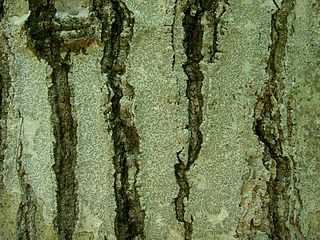
Eurotiomycetes is a large class of ascomycetes with cleistothecial ascocarps within the subphylum Pezizomycotina, currently containing around 3810 species according to the Catalogue of Life. It is the third largest lichenized class, with more than 1200 lichen species that are mostly bitunicate in the formation of asci. It contains most of the fungi previously known morphologically as "Plectomycetes".

Pleosporaceae is a family of sac fungi. They are pathogenic to humans or saprobic on woody and dead herbaceous stems or leaves.

Diaporthales is an order of sac fungi.

The Amphisphaeriaceae are a family of fungi that is mainly found in parts of New Zealand, South America, Asia and parts of Europe. According to the 2007 Outline of Ascomycota, there were 41 genera placed within the family, although the position of 13 of those genera is uncertain. The 2020 Outline of Fungi and fungus-like taxa severely reduced the family to 4 members.

The Ostropomycetidae are a subclass of mostly lichen-forming fungi in the class Lecanoromycetes. The subclass was circumscribed in 2004 by Catherine Reeb, François M. Lutzoni, and Claude Roux. It contains ten orders and 36 families.
Calyptra is a genus of fungi in the class Dothideomycetes. The relationship of this taxon to other taxa within the class is unknown.
Neoventuria is a genus of fungi in the class Dothideomycetes. The relationship of this taxon to other taxa within the class is unknown. A monotypic genus, it contains the single species Neoventuria argentinensis.
Licopolia is a genus of fungi in the class Dothideomycetes. The relationship of this taxon to other taxa within the class is unknown. Also, the placement of this genus within the Dothideomycetes is uncertain.
Allophoron is a genus of fungi in the division Ascomycota. The relationship of this taxon to other taxa within the division is unknown, and it has not yet been placed with certainty into any class, order, or family. This is a monotypic genus, containing the single lichen species Allophoron farinosum, found in Colombia. The genus and species were described as new in 1942 by Czech lichenologist Josef Nádvorník.
Gyrophthorus is a genus of lichenicolous (lichen-dwelling) fungi in the phylum Ascomycota. The relationship of this taxon to other taxa within the phylum is unknown, and it has not yet been placed with certainty into any class, order, or family. The genus was circumscribed in 1990 by Josef Hafellner and Leopoldo Sancho, with Gyrophthorus perforans assigned as the type species.
Phragmitensis is a genus of fungi in the Ascomycota phylum.
Endoscypha is a genus of fungi in the Helotiales order. The relationship of this taxon to other taxa within the order is unknown, and it has not yet been placed with certainty into any family. This is a monotypic genus, containing the single species Endoscypha perforans. The genus and species were described as new to science in 1924 by German mycologist Hans Sydow.
Aquaticola is a genus of fungi in the Cephalothecaceae family of the Ascomycota. The relationship of this taxon to other taxa within the Sordariomycetes class is unknown, except that it is in subclass Diaporthomycetidae, and it has not yet been placed with certainty into any order.
Cyanoannulus is a fungal genus in the family Annulatascaceae of the Ascomycota. This is in the monotypic order of Annulatascales of the class Sordariomycetes. It was formerly classed as Sordariomycetes class in 2007.
Diluviicola is a genus of fungi in the Pseudoproboscisporaceae family and Atractosporales order, within the subclass class of Diaporthomycetidae.
Fusoidispora is a fungal genus in the Annulatascaceae family of the Ascomycota. The relationship of this taxon to other taxa within the Sordariomycetes class is unknown, except that it is in subclass Diaporthomycetidae, and it has not yet been placed with certainty into any order. This is a monotypic genus, containing the single species Fusoidispora aquatica.
Hapsidospora is a genus of fungi in the Hypocreales order. The relationship of this taxon to other taxa within the order is unknown, and it has not yet been placed with certainty into any family. Unchanged in 2020.
Peloronectria is a genus of fungi in the Hypocreales order. The relationship of this taxon to other taxa within the order is unknown, and it has not yet been placed with certainty into any family. Unchanged in 2020.
Pseudomeliola is a genus of fungi in the Hypocreales order. The relationship of this taxon to other taxa within the order is unknown, and it has not yet been placed with certainty into any family. Unchanged in 2020.
Xenus lithophylli is a species of lichenized ascomycete fungus discovered in 1992, composing the entire monotypic genus Xenus. It is found parasiting the calcified algae Lithophyllum, and lives attached to corals in Belize, in the Caribbean.




